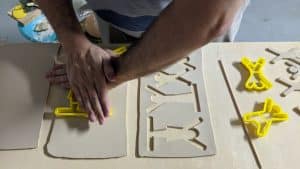Did you know that clay has many different forms? I did not until I started working with it, and even then, I called it ‘wet’, ‘not-so-wet’, ‘a bit hard’ and ‘hard’. I have since learnt there are better names for these stages.
- Slip – this is the form of clay where it is almost more water than clay depending on the consistency. Slip forms naturally as you put water on the clay while throwing, it lubricates the clay and allows it to move more freely. Slip can be used to decorate (slip trailing is an example) and can be used like a glaze layer (coloured slip is excellent for this). There is an entire technique in ceramics called Slip Casting that uses slip to form pieces. I will write more on this later as this is a skill I would like to learn.
- Plastic or wet – this is the workable clay consistency. If you touch this clay, you will leave a fingerprint. You can throw this clay, make slabs and coils, this is the first of the creative stages. If the clay starts to dry, you can wet, it to take it back to a plastic state. At this stage, you can join pieces together, and you can recycle the clay scraps back into plastic clay.
- Leather hard – The is clay that is cool to touch, and when you handle it, you will not leave a fingerprint; however, it is soft enough that you could dig your fingernail into it. When the clay is like this, it is ready to trim, is suitable for slab construction as it holds its shape and is prepared to carve. At this stage, you can join pieces together, and you can recycle the clay scraps back into plastic clay.
- Bone dry (greenware) – Clay that is thoroughly air-dried and no longer cool to touch. At this point, it is extremely brittle and fragile. The pieces need to be bone dry to go in the kiln; otherwise, they are at a higher risk of cracking. This clay can still be recycled back to plastic clay.
- Bisque (bisque ware) – This is finished pieces that have been through the kiln for the first time and bisque fired. Bisque firing is a long firing process that forces ALL the water (including chemically bonded) out of the piece. It transforms the clay into a durable semi-vitrified porous stage where it can be safely handled during the glazing and decoration stages. At this point, the clay can no longer be recycled back to plastic clay.
- Glazed (glaze ware) – this is the second time the piece goes into the kiln. The glaze firing is a firing process that enables the glaze to fuse to the ceramic body of the vessel. The glaze then becomes an impervious layer on the piece. It is now finished.



